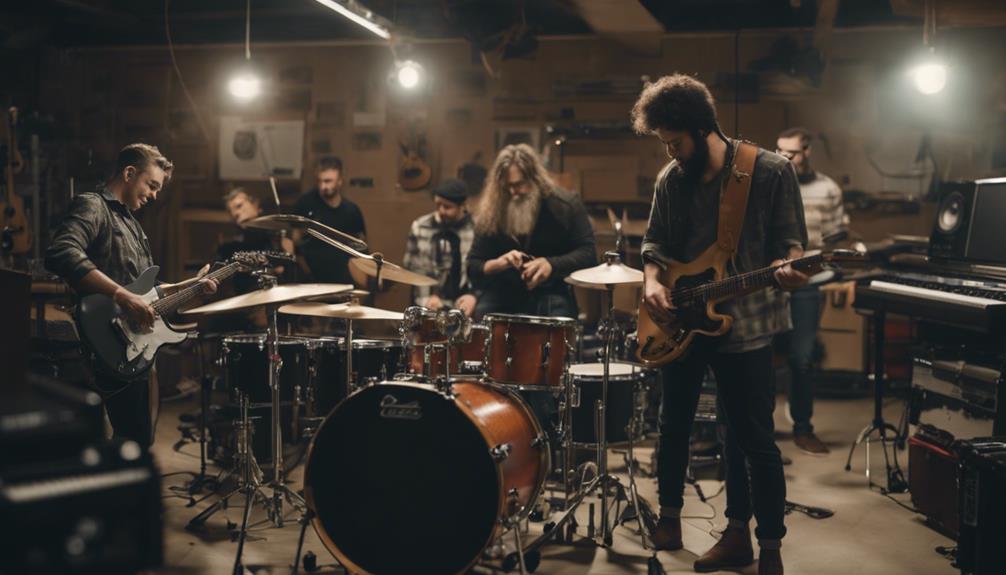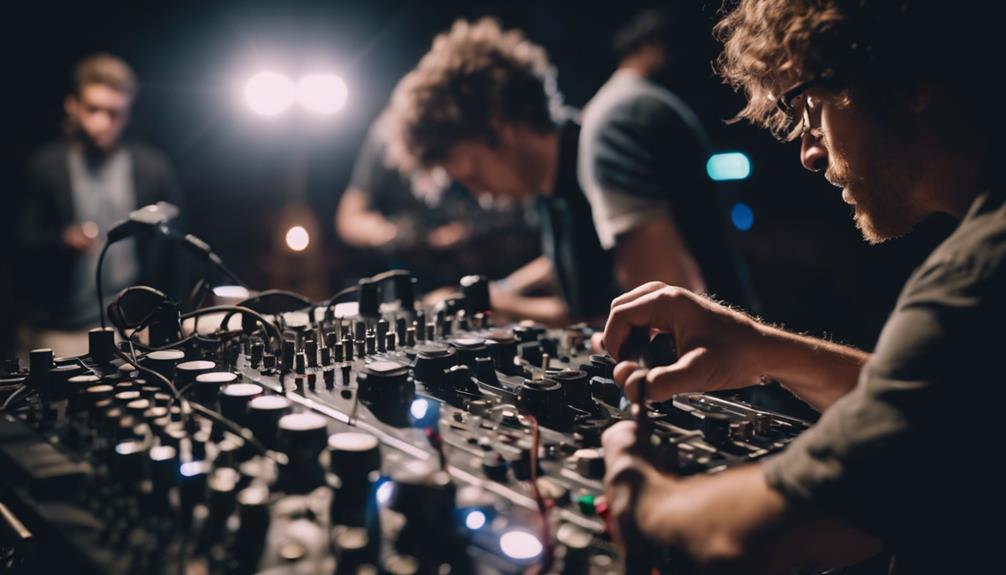When you’re gearing up for a live show, it’s essential to start with regular rehearsals to perfect your songs and build confidence. You can’t underestimate the importance of a well-memorized setlist, as it allows you to focus entirely on the crowd.
Testing your equipment beforehand and having backups ready will save you from potential headaches. Additionally, effective communication with your bandmates and fostering a cohesive group dynamic can make or break your performance.
But how do you truly captivate your audience and read their energy to create an unforgettable experience? It’s more than just them listening to your songs after you release them online.
Let’s explore the essential steps to mastering live performances.
TL-DR
- Rehearse regularly to perfect songs, synchronize playing, and enhance stage presence.
- Memorize your setlist to ensure seamless performances and focus on audience engagement.
- Test all equipment before the show and have backups ready for emergencies.
- Communicate effectively with bandmates to ensure everyone understands their roles and prevent misunderstandings.
- Engage with the audience through eye contact, body language, and direct communication to build rapport and energy.
Rehearse Regularly

Regular rehearsals are essential for perfecting your songs and building confidence on stage. When your band practices consistently, you fine-tune your sound and synchronize your playing, making your live performances smoother and more polished. This regular practice helps you nail down those tricky shifts between songs, guaranteeing your set flows seamlessly from one track to the next.
One of the key benefits of rehearsing is the improvement of your stage presence. As you rehearse, you become more comfortable with the music and your movements, making it easier to engage with your audience. A confident and cohesive performance captivates spectators and keeps them coming back for more.
To make the most of your rehearsal time, focus on the technical aspects of your performance. Adjust sound levels, troubleshoot any equipment issues, and practice your set as if you’re performing live. This preparation not only enhances your music but also ensures that technical problems don’t disrupt your show.
Memorize Your Setlist
Memorizing your setlist guarantees you deliver a seamless and professional performance. When you know your songs by heart, you can focus entirely on engaging with the audience, rather than worrying about what comes next. This memorization minimizes the risk of mistakes, boosting your confidence on stage. As a result, you maintain the flow of the show, ensuring smooth adjustments between songs.
During live shows, unexpected changes can happen. Maybe the setlist needs to adapt due to time constraints or audience requests. Knowing your setlist inside out allows you to make these modifications effortlessly, keeping the performance on track and the audience entertained. Confidence in your setlist also means you can handle any hiccups without losing your composure, which is important for maintaining a professional demeanor.
Moreover, being familiar with your setlist lets you focus on the subtler aspects of your performance. You can make eye contact with the audience, move around the stage, and truly connect with your fans. This level of engagement elevates your live shows, turning them into memorable experiences.
Prepare Your Equipment

Before your show, make sure you test all your gear to catch any issues early.
Always have backup essentials like strings, picks, and batteries ready for emergencies.
Label your equipment and use a checklist to guarantee nothing important is left behind.
Test All Gear
Make sure every piece of gear is in perfect working order by testing each instrument individually before the show. Start by verifying your equipment, making sure each component, including your guitar, bass, keyboard, or drums, is functioning correctly. Test all gear thoroughly; don’t overlook anything. Check cables for any signs of wear or damage and make sure they’re fully operational. Amplifiers should be tested by playing through them to catch any issues that might cause technical difficulties during your performance.
Create a checklist of all necessary gear and accessories to make certain nothing is forgotten or left behind. This list should include instruments, cables, pedals, amplifiers, and any other equipment you’ll need. Familiarize yourself with the venue’s sound system and its technical requirements. This will help you adapt your gear accordingly, ensuring compatibility and top-notch sound quality.
Conduct individual gear testing in a quiet space so you can clearly hear any potential problems. Address these issues well in advance of the show. By taking these steps, you’ll minimize the risk of technical difficulties and set yourself up for a smooth, successful live performance.
Backup Essentials Ready
Having backup essentials ready guarantees you’re fully prepared for any unexpected issues that might arise during your live show. Start by making sure you have extra cables, strings, picks, drumsticks, and batteries. These small items can save your performance if something goes wrong.
Always have a backup instrument on hand in case of technical issues or malfunctions. This way, you can quickly switch without missing a beat.
Additionally, pack a reliable tuner, amplifier, and spare parts to address any equipment failures on stage. Keep essential tools like screwdrivers, pliers, and guitar picks in your gig bag for quick fixes. These tools are essential when time is of the essence, and you need to make swift adjustments or repairs.
Don’t forget to prioritize equipment maintenance. Regular checks and upkeep can prevent unexpected failures during live shows. A well-maintained setup is less likely to cause problems, but having backup essentials ready ensures you’re covered if something does go awry.
Collaborate With Bandmates
To guarantee a seamless live show, communicate effectively with your bandmates and share your setlists in advance.
Schedule regular rehearsals to fine-tune song arrangements and stage movements.
Communicate Effectively
Effective communication with your bandmates is essential for guaranteeing a polished and engaging live performance. Before live shows, discuss setlists, arrangements, and performance cues thoroughly. This ensures everyone is on the same page and understands their roles.
During rehearsals, collaborate closely with your bandmates to nail down seamless shifts and coordinated stage presence. Clear and concise communication is key; it helps convey ideas, feedback, and suggestions that enhance your overall team performance.
Fostering a positive and open communication environment within the band is pivotal. Address any issues or concerns that might arise before or during live shows without hesitation. This openness helps prevent misunderstandings and keeps everyone’s morale high.
Establishing a mutual understanding among bandmates regarding individual roles and responsibilities is essential. It creates a cohesive and harmonious live performance experience, making the entire band look and sound more professional.
Share Setlists
Once you’ve established clear communication with your bandmates, it’s time to collaborate on creating a cohesive setlist. A well-crafted setlist not only flows seamlessly but also showcases each member’s strengths. Sharing setlists in advance guarantees everyone can practice individually and come prepared for the live show.
To create a strong setlist, follow these steps:
- Include a Diverse Selection: Involve all bandmates in song choices to cater to the audience and venue. A varied setlist keeps the performance dynamic and engaging.
- Utilize Digital Tools: Use apps or digital platforms for setlist sharing to make revisions and updates accessible to everyone. This streamlines the process and ensures everyone is on the same page.
- Encourage Open Communication: Actively seek feedback from your bandmates on the setlist. Open discussions help identify any potential issues and allow for necessary adjustments.
- Showcase Strengths: Make sure the setlist highlights the unique talents of each band member. This not only boosts individual confidence but also enhances the overall performance.
Schedule Rehearsals
Coordinating regular rehearsals with your bandmates is essential for honing your performance and making sure everyone is in sync. Consistent practice is key to nailing those live gigs, and scheduling these sessions can be a breeze with the right tools. Use shared calendars or scheduling apps to find rehearsal times that fit everyone’s schedules. This approach minimizes conflicts and keeps the band on track.
Set specific goals for each rehearsal to maximize productivity. Whether you’re working on a new setlist or tightening up connections, having clear objectives helps everyone stay focused. Rotate leadership roles within the band to keep things fresh and make sure every member can contribute their ideas. This fosters a collaborative environment and keeps rehearsals engaging.
Establish open communication channels to address any scheduling conflicts promptly. Whether it’s a group chat or an email thread, make sure everyone can easily update the group about their availability. This transparency ensures everyone is on the same page and can adjust plans as needed.
Engage With Audience

Engaging with your audience during a live show is vital for creating an unforgettable experience. To truly connect during your performance, make eye contact with audience members. This simple act helps establish a genuine connection and shows you’re fully engaged with the crowd.
Encourage crowd participation through call-and-response moments or sing-alongs to foster a lively, interactive atmosphere.
Address the audience directly between songs to build rapport, sharing stories or insights that can make the performance more memorable. Your body language and movement on stage are essential; they captivate the audience and convey the energy and emotion of your music effectively.
Here are four key points to help you engage with your audience:
- Eye Contact: Look into the crowd and make eye contact with individuals to create a personal connection.
- Crowd Participation: Involve the audience with call-and-response or sing-along parts to make them feel part of the show.
- Address Audience: Speak to the audience between songs to build a connection and share meaningful stories or insights.
- Body Language and Movement: Use expressive body language and move around the stage to keep the audience engaged and convey your music’s emotions.
Show appreciation for their support by sincerely thanking the audience and acknowledging their presence throughout the performance. This genuine gratitude will leave a lasting impression.
Develop Stage Presence
To develop a commanding stage presence, start by exuding confidence and charisma that captivates your audience from the moment you step on stage. Engage in audience interaction by making eye contact and talking to them between songs. This connection builds an intimate atmosphere that draws everyone in.
Movement on stage is vital. Don’t just stand in one spot; use the entire stage to keep the energy and dynamics high. Whether it’s a powerful strut or a subtle sway, your movement can amplify the emotions of your performance.
Creating a stage persona or alter ego can help you showcase confidence. This persona allows you to step out of your everyday self and fully embody the performer you aspire to be.
Collaborate with your band members to ensure a cohesive and synchronized performance. Practice regularly to perfect your timing and coordination, making your show seamless and professional.
Reading the audience’s reactions is essential for an impactful live show. Adjust your performance based on their energy levels—if they’re hyped, keep the momentum going; if they’re mellow, bring them up. This adaptability can turn a good performance into an unforgettable one.
Read Audience Energy

Sensing the audience’s energy is essential for delivering a dynamic and engaging live performance. Pay close attention to the audience’s body language, facial expressions, and reactions to gauge their energy level. By observing these cues, you can identify whether the crowd is fully engaged or if they need a little more excitement.
Look for signs of engagement, such as:
- Clapping, dancing, or singing along.
- Nodding heads and tapping feet.
- Smiling and making eye contact.
- Active participation and cheering.
These indicators can help you assess the audience’s connection to your music. Once you’ve identified the energy level, you can use it to motivate yourself and deliver an even more impactful performance.
It’s important to interact with the audience through eye contact, gestures, and verbal communication to build rapport and enhance the live show experience. Acknowledge their presence and make them feel part of the performance.
Adjust Performance
Adapting your performance to the unique characteristics of each venue and audience can make all the difference in creating an unforgettable live show. The size of the venue plays an important role in how you should adapt your live performance. In a small, intimate club, you might want to tone down your energy level and focus on more personal audience engagement.
Conversely, at a large outdoor festival, ramping up your stage presence and energy level can help you connect with a larger crowd.
Modifying your setlist to suit the specific vibe of each live show is also essential. A more laid-back venue might call for slower, more acoustic songs, while a high-energy crowd at a festival will appreciate your most upbeat tracks. Pay close attention to crowd reactions throughout the show and be ready to adapt in real-time. If the audience seems to lose interest, switch things up to recapture their attention.
Flexibility in your performance approach, including how you interact with the audience, can greatly enhance their overall enjoyment. By adjusting your performance style and maintaining a dynamic presence on stage, you’ll make sure that each show is a memorable experience for everyone involved.
Next up, why not learn more about how to promote your music in this guide.
